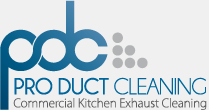NFPA 96 Standards
11.3 Inspection of Exhaust Systems
The entire exhaust shall be inspected by a properly trained, qualified, and certified company or person (s) acceptable to the authority having jurisdiction in accordance with Table 11.3
Table 11.3 Exhaust System Inspection Schedule
| Type or Volume of Cooking Frequency | Frequency |
|---|---|
| Systems serving solid fuel cooking operations | Monthly |
| Systems serving high-volume cooking operations such as 24-hour cooking, charbroiling, or wok cooking. | Quarterly |
| Systems serving moderate-volume cooking operations. | Semi-annually |
| Systems serving low-volume cooking operations, such as churches, day camps, seasonal businesses, or senior centers. | Annually |
11.4 Cleaning of Exhaust Systems
Upon inspection, if found to be contaminated with deposits from grease-laden vapors, the entire exhaust system shall be cleaned by a properly trained, qualified, and certified individual acceptable to the authority having jurisdiction in accordance with Section 11.3.
11.4.2 Hoods, grease removal devices, fans, ducts, and other appurtenances shall be cleaned to bare metal prior to surfaces becoming heavily contaminated with grease or oily sludge.
11.4.3 At the start of the cleaning process, electrical switches that could be activated accidentally shall be locked out.
11.4.4 Components of the fire suppression system shall not be rendered inoperable during the cleaning process.
11.4.5 Fire-extinguishing systems shall be permitted to be rendered inoperable during the cleaning process where serviced by properly trained and qualified persons in accordance with Section 11.3.
11.4.6 Flammable solvents or other flammable cleaning aids shall not be used.
11.4.7 Cleaning chemicals shall not be applied on fusible links or other detection devices or the automatic extinguishing system.
11.4.8 After the exhaust system is cleaned to bare metal, it shall not be coated with powder or other substance.
11.4.9 All access panels (doors) and cover plates shall be replaced.
11.4.10 Dampers and diffusers shall be positioned for proper airflow.
11.4.11 When cleaning procedures are completed, all electrical switches and system components shall be returned to an operable state.
11.4.12 When a vent cleaning service is used, a certificate showing date of inspection or cleaning shall be maintained on the premises.
11.4.13 After cleaning is completed, the vent cleaning contractor shall place or display within the kitchen area a label indicating the date cleaned and the name of the servicing company, and areas not cleaned.
4.1.8 All interior surfaces of the exhaust system shall be accessible for cleaning and inspection purposes.
6.2.3.3 Grease filters shall be arranged so that all exhaust air shall pass through the grease filters.
14.1.6 Solid fuel cooking operations shall have spark arresters to minimize the passage of airborne sparks and embers into plenums and ducts.
14.3.3 All solid fuel cooking equipment served by hood and duct systems shall be separate from all other exhaust systems.
14.5.2 If airborne sparks and embers can be generated by the solid fuel cooking operation, spark arrester devices shall be used prior to the grease removal device to minimize the entrance of these sparks and embers into the grease removal device and into the hood and duct system.
Reprinted with permission from NFPA 96 Standard for Ventilation Control and Fire Protection of Commercial Cooking Operations © National Fire Protection Association, Quincy, MA 02269. The reprinted material is not the complete and official position of the National Fire Protection Association, on the referenced subject which is represented only by the standard in its entirety.





